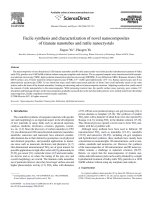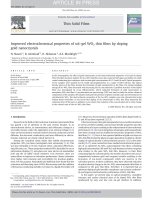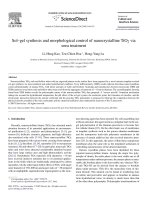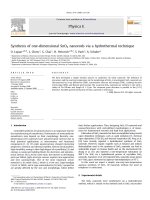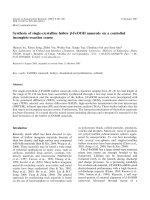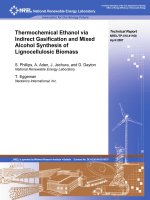- Trang chủ >>
- Khoa Học Tự Nhiên >>
- Vật lý
synthesis of wo3tio2 nanocomposites via sol–gel method
Bạn đang xem bản rút gọn của tài liệu. Xem và tải ngay bản đầy đủ của tài liệu tại đây (99.12 KB, 3 trang )
Journal of Alloys and Compounds 398 (2005) 200–202
Synthesis of WO
3
/TiO
2
nanocomposites via sol–gel method
Huaming Yang
a,∗
, Rongrong Shi
a
, Ke Zhang
a
, Yuehua Hu
a
, Aidong Tang
b
, Xianwei Li
c
a
Department of Inorganic Materials, School of Resources Processing and Bioengineering, Central South University, Changsha 410083, China
b
Institute of Functional Materials, School of Chemistry and Chemical Engineering, Central South University, Changsha 410083, China
c
Institute of Resources and Environmental Engineering, Technology Centre, Baoshan Iron and Steel Co. Ltd., Shanghai 201900, China
Received 23 December 2004; received in revised form 31 January 2005; accepted 1 February 2005
Available online 4 March 2005
Abstract
Synthesis of WO
3
/TiO
2
nanocomposites by a sol–gel method was investigated using differential thermal analysis (DTA), X-ray diffraction
(XRD) and transmission electron microscopy (TEM) techniques. Thermal treatment of the precursor at 400
◦
C in air resulted in the formation
of WO
3
/TiO
2
nanocomposites with a particle size of about 60nm. The c-axis parameter of TiO
2
in the WO
3
/TiO
2
nanocomposites, lower than
that of pure TiO
2
, increased with increasing calcination time. Doping TiO
2
with WO
3
can lower its band gap and shift its optical response to
the visible region. This nanocomposite should be effective as a visible-light-driven photocatalyst.
© 2005 Elsevier B.V. All rights reserved.
Keywords: WO
3
/TiO
2
nanocomposites; Photocatalysis; Sol–gel method; Lattice parameters
1. Introduction
It is well known that nanosized TiO
2
powder is one of
the suitable semiconductors for photocatalyst and has been
widely applied in various photocatalytic fields, such as en-
vironmental purification, decomposition of organic contam-
inants and water photosplitting into H
2
and O
2
[1–5].How-
ever, its properties, not only the photo-efficiency or activity
but also the photoresponse, are not sufficient [6]. The vital
snag of TiO
2
semiconductor is that it only absorbs a small
portion of solar spectrum in the ultraviolet (UV) region (band
gap energy of pure TiO
2
is 3.2 eV). Hence, in order to absorb
maximum solar energy, it is necessary to shift the absorption
threshold towards the visible region. The high recombina-
tion ratio of photo-induced hole–electron pairs also reduces
its catalytic efficiency. Recently, various modifications have
been performed on nanosized TiO
2
to extend its optical ab-
sorption edge into the visible light region and to improve its
photocatalytic activity, including surface modification, metal
depositing, transition metal and transition metal oxide com-
plexes [7–13]. Coupling TiO
2
with WO
3
, which is a semi-
∗
Corresponding author. Tel.: +86 731 8830 549; fax: +86 731 8710 804.
E-mail address: (H. Yang).
conductor used as photocatalyst (E
g
= 2.8 eV), can achieve
an efficient charge separation. It is reported that WO
3
/TiO
2
nanocomposites have higher photocatalytic activity [14,15].
In this paper, synthesis of WO
3
/TiO
2
nanocomposites via the
sol–gel method was attempted.
2. Experimental details
The starting materials were AR-grade Ti(OBu
4
), am-
monium tungstate and anhydrous alcohol. Ten millilitres
Ti(OBu
4
) was dissolved in 10 ml anhydrous alcohol, and ul-
trasonicallydispersedtoformamixture.Five millilitres water
was slowly dripped into the mixture, which wasstirred for1 h
at room temperature. Then different additions of ammonium
tungstate solution were dripped into the mixture according to
the required amount of WO
3
in the WO
3
/TiO
2
nanocompos-
ites. The pH value of the solution was kept to be 10. The so-
lution was aged for 12h at ambient temperature, followed by
filtering, washing for several times with deionized water and
anhydrous alcohol, drying at 80
◦
C for 12h to produce a pre-
cursor. Subsequent calcination of the precursor at 400
◦
C for
different hours in air resulted in the formation of WO
3
/TiO
2
nanocomposites.
0925-8388/$ – see front matter © 2005 Elsevier B.V. All rights reserved.
doi:10.1016/j.jallcom.2005.02.002
H. Yang et al. / Journal of Alloys and Compounds 398 (2005) 200–202 201
Differential thermal analysis (DTA) of the precursor was
carried out using an SDT2960 thermal analyzer at a heat-
ing rate of 10
◦
/min. The structure of the sample was ex-
amined using a D/max-␥A diffractometer (Cu K␣ radiation,
λ = 0.154056nm). The morphology of the nanocomposites
was observed using a JEM-200CX transmission electron mi-
croscope (TEM). The UV–vis absorption spectra of the sam-
ples were recorded on a Shimadzu UV-3101PC spectropho-
tometer.
3. Results and discussion
TheprecursorwassubjectedtoDTAanalysis.Thepurpose
was to determine thetemperatures of possible decomposition
and phase changes of the precursor during the thermal treat-
ment. Fig. 1shows the typicalDTAcurves forthe as-prepared
precursor. The exothermic peak round 280
◦
C is associated
with the decomposition of residual
OH groups and the con-
densationofnonbondedoxygen.Anexothermicpeakatabout
430
◦
Cwasclearlyobserved,whichpossiblycanbeattributed
to thecrystallization alterationof theanatase TiO
2
phase. But
there still exists a little difference in exothermic peak around
430
◦
C for the nanoparticle precursor with different amount
of WO
3
.
Fig. 2 shows the X-ray diffraction (XRD) patterns of
10 wt% and 20 wt% WO
3
/TiO
2
nanocomposites after cal-
cination at 400
◦
C for 12h. As can be seen, all the peaks can
be assigned to anatase TiO
2
and no crystalline WO
3
was de-
tected. Ma et al. [14] also reported the same result in their
Fig. 1. DTA curves of the precursor with different amount of WO
3
(a)
10 wt%, (b) 20wt% and (c) 40 wt%.
Fig. 2. XRD patterns of the WO
3
/TiO
2
nanocomposites with different
amounts of WO
3
(a) 10 wt% and (b) 20wt%, respectively.
Fig. 3. XRD patterns of 40 wt% WO
3
/TiO
2
nanocomposites after calcined
at 400
◦
C for different hours (a) 4h, (b) 8 h and (c) 12 h, respectively.
studies, they thought that amorphous tungsten oxide phase
covered the TiO
2
surface.
Fig. 3 shows the XRD patterns of 40wt% WO
3
/TiO
2
nanocomposites after calcination at 400
◦
C for (a) 4 h, (b) 8h
and (c) 12h, respectively. As shown in Fig. 3, the WO
3
/TiO
2
nanocomposites prepared by the sol–gel method was ob-
servedtohave theanatasestructureandtungstenoxide,show-
ing the presence of a sharp peak at 25.3
◦
of 2θ which is the
major peak for the anatase TiO
2
. Due to the increase in the
calcination time, the intensities of the peaks associated with
WO
3
increased to some extent. Fig. 4 shows a TEM micro-
graph of the 40 wt% WO
3
/TiO
2
nanocomposites after heat
treatmentat400
◦
Cfor12 h. The particle size of the nanocom-
posites observed in the TEM image was about 60nm indiam-
eter, while monodispersive particles with uniform size were
present.
The lattice parameters (a and c) of pure TiO
2
and
WO
3
/TiO
2
nanocomposites after calcination were calculated
using the formula:
1
d
2
=
h
2
+ k
2
a
2
+
l
2
c
2
(1)
where d is the interplane spacing, h, k and l are all Miller’s
indices. The values were listed in Table 1. The lattice param-
eters of pure anatase TiO
2
obtained by the sol–gel method
are a = b= 3.7523
˚
A, c = 10.0664
˚
A. It is clear that the lattice
parameters increase along the a- and b-axes while the c-axis
parameter decreases as tungsten oxide was doped. Longer
Fig. 4. TEM image of the 40 wt% WO
3
/TiO
2
nanocomposites.
202 H. Yang et al. / Journal of Alloys and Compounds 398 (2005) 200–202
Table 1
The lattice parameters of TiO
2
in WO
3
/TiO
2
nanocomposites
a
Samples Calcination time (h) a (=b)(
˚
A) c (
˚
A)
Pure TiO
2
12 3.7523 10.0664
10 wt% WO
3
/TiO
2
12 3.7961 9.3540
20 wt% WO
3
/TiO
2
12 3.7836 9.6761
40 wt% WO
3
/TiO
2
12 3.7903 9.5307
40 wt% WO
3
/TiO
2
8 3.7908 9.5172
40 wt% WO
3
/TiO
2
4 3.7914 9.5100
a
Calcination temperature was 400
◦
C.
Fig. 5. UV–vis absorption spectra of the sample.
calcination time resulted in an increase in c-axis parameter
of the 40 wt% WO
3
/TiO
2
nanocomposites. The decrease in
the lattice parameters of the WO
3
/TiO
2
nanocomposites in
comparison to pure TiO
2
may be attributed to the decrease
in the cation size in the octahedral site. The W
6+
ions have
a lower ionic radius (41 pm) than Ti
4+
(53 pm) in the octa-
hedral site of TiO
2
. This result also indicates that a doping
effect exists in the WO
3
/TiO
2
composite nanocrystallites.
Fig. 5 shows the absorption spectrum of the WO
3
/TiO
2
nanocomposites. The spectrum shows that the onset of ab-
sorption appears at about 475 nm. The onset of the optical
absorption of WO
3
/TiO
2
particles relative to the bulk anatase
TiO
2
(λ
E
= 387 nm) implies a red shift. The band gap energy
of the nanocomposites can be determined to be 2.67 eV from
the transformed Kubelka–Munk function, while the band gap
energy of pure TiO
2
is about 3.2eV, accordingly, this absorp-
tion feature suggests that the WO
3
/TiO
2
photocatalyst can
possibly be activated by the visible light, which can absorb
the maximum solar energy.
4. Conclusions
In summary, WO
3
/TiO
2
nanocomposites have been suc-
cessfully prepared by a sol–gel method. The intensities of the
XRD peaks associated with TiO
2
increased gradually with
increasing calcination time. Addition of WO
3
resulted in a
decrease in the c-axis parameter of the TiO
2
, which also in-
creasedwithincreasingcalcinationtime.Thisnanocomposite
is promising for high-performance visible-light-driven pho-
tocatalysts. A detailed study on the photocatalytic activity of
the nanocomposite is in progress.
Acknowledgement
This work was financially supported by the National
Natural Science Foundation of China (Nos. 50304014,
50474046).
References
[1] H.S. Bae, M.K. Lee, Colloids Surf. A 220 (2003) 169.
[2] L. Znaidi, R. S
´
eraphimova, Mater. Res. Bull. 36 (2001) 811.
[3] Q. Zhang, L. Gao, J. Guo, Appl. Catal. B 26 (2000) 207.
[4] S. Goeringer, C.R. Chenthamarakshan, K. Rajeshwar, Electrochem.
Commun. 3 (2001) 290.
[5] Z. Wang, U. Helmersson, P O. Kall, Thin Solid Films 405 (2002)
50.
[6] T. Kawai, T. Sakata, J. Chem. Soc. Chem. Commun. 15 (1980)
694.
[7] T. Ohno, S. Saito, K. Fujihara, M. Matsumura, Bull. Chem. Soc.
Jpn. 69 (1996) 3059.
[8] B. Ohtani, K. Iwai, S. Nishimoto, S. Sato, J. Phys. Chem. B 101
(1997) 3349.
[9] M.I. Litter, Appl. Catal. B 23 (1999) 89.
[10] J.A. Nav
´
ıo, J.J. Testa, P. Djedjeian, T.R. Padr
´
on, Appl. Catal. A 178
(1999) 191.
[11] W. Choi, A. Termin, M. Hoffmann, J. Phys. Chem. 98 (1994)
13669.
[12] T. Nishikawa, T. Nakajima, Y. Shinohara, THEOCHEM 545 (2001)
67.
[13] M.D. Amiridis, R.V. Duevel, I.E. Wachs, Appl. Catal. B 20 (1999)
111.
[14] Z. Ma, W. Hua, Y. Tang, Chem. Lett. 28 (1999) 1215.
[15] H. Yang, D. Zhang, L. Wang, Mater. Lett. 57 (2002) 674.

